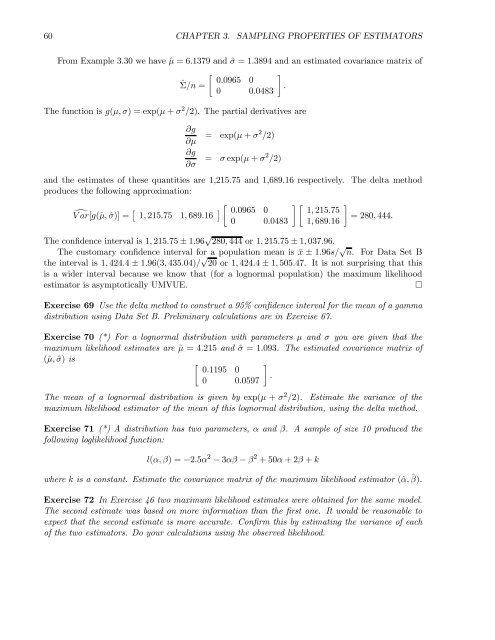Estimation, Evaluation, and Selection of Actuarial Models
Estimation, Evaluation, and Selection of Actuarial Models
Estimation, Evaluation, and Selection of Actuarial Models
Create successful ePaper yourself
Turn your PDF publications into a flip-book with our unique Google optimized e-Paper software.
60 CHAPTER 3. SAMPLING PROPERTIES OF ESTIMATORS<br />
From Example 3.30 we have ˆµ =6.1379 <strong>and</strong> ˆσ =1.3894 <strong>and</strong> an estimated covariance matrix <strong>of</strong><br />
· ¸<br />
0.0965 0<br />
ˆΣ/n =<br />
.<br />
0 0.0483<br />
The function is g(µ, σ) =exp(µ + σ 2 /2). The partial derivatives are<br />
∂g<br />
∂µ = exp(µ + σ2 /2)<br />
∂g<br />
∂σ = σ exp(µ + σ2 /2)<br />
<strong>and</strong> the estimates <strong>of</strong> these quantities are 1,215.75 <strong>and</strong> 1,689.16 respectively. The delta method<br />
produces the following approximation:<br />
dVar[g(ˆµ, ˆσ)] = £ 1, 215.75 1, 689.16 ¤ · 0.0965 0<br />
0 0.0483<br />
¸· 1, 215.75<br />
1, 689.16<br />
¸<br />
= 280, 444.<br />
The confidence interval is 1, 215.75 ± 1.96 √ 280, 444 or 1, 215.75 ± 1, 037.96.<br />
The customary confidence interval for a population mean is ¯x ± 1.96s/ √ n. For Data Set B<br />
the interval is 1, 424.4 ± 1.96(3, 435.04)/ √ 20 or 1, 424.4 ± 1, 505.47. It is not surprising that this<br />
is a wider interval because we know that (for a lognormal population) the maximum likelihood<br />
estimator is asymptotically UMVUE. ¤<br />
Exercise 69 Use the delta method to construct a 95% confidence interval for the mean <strong>of</strong> a gamma<br />
distribution using Data Set B. Preliminary calculations are in Exercise 67.<br />
Exercise 70 (*) For a lognormal distribution with parameters µ <strong>and</strong> σ you are given that the<br />
maximum likelihood estimates are ˆµ =4.215 <strong>and</strong> ˆσ =1.093. The estimated covariance matrix <strong>of</strong><br />
(ˆµ, ˆσ) is<br />
· 0.1195 0<br />
0 0.0597<br />
The mean <strong>of</strong> a lognormal distribution is given by exp(µ + σ 2 /2). Estimate the variance <strong>of</strong> the<br />
maximum likelihood estimator <strong>of</strong> the mean <strong>of</strong> this lognormal distribution, using the delta method.<br />
Exercise 71 (*) A distribution has two parameters, α <strong>and</strong> β. A sample <strong>of</strong> size 10 produced the<br />
following loglikelihood function:<br />
¸<br />
.<br />
l(α, β) =−2.5α 2 − 3αβ − β 2 +50α +2β + k<br />
where k is a constant. Estimate the covariance matrix <strong>of</strong> the maximum likelihood estimator (ˆα, ˆβ).<br />
Exercise 72 In Exercise 46 two maximum likelihood estimates were obtained for the same model.<br />
The second estimate was based on more information than the first one. It would be reasonable to<br />
expectthatthesecondestimateismoreaccurate. Confirm this by estimating the variance <strong>of</strong> each<br />
<strong>of</strong> the two estimators. Do your calculations using the observed likelihood.
















